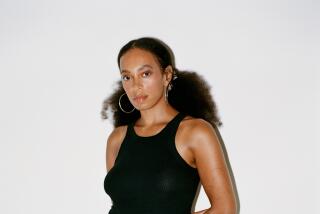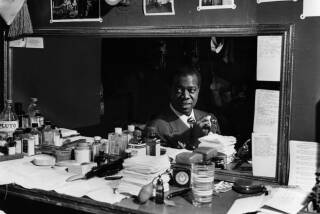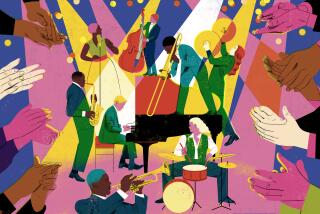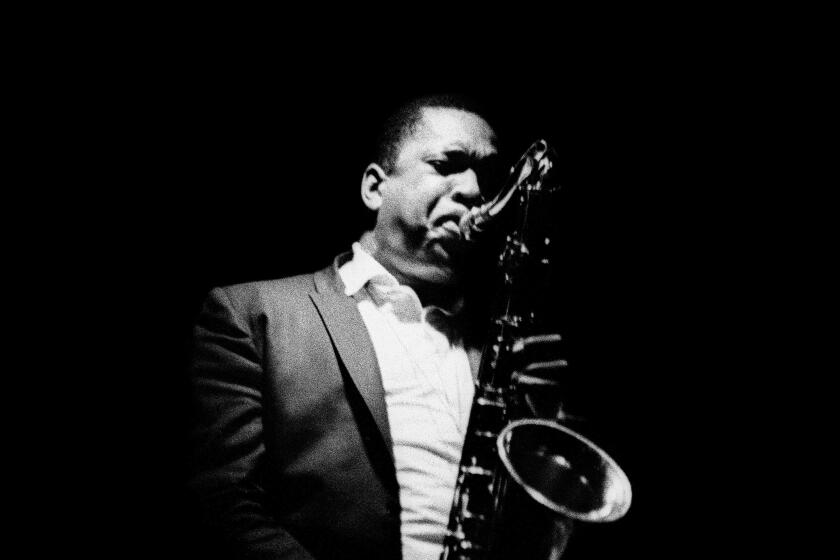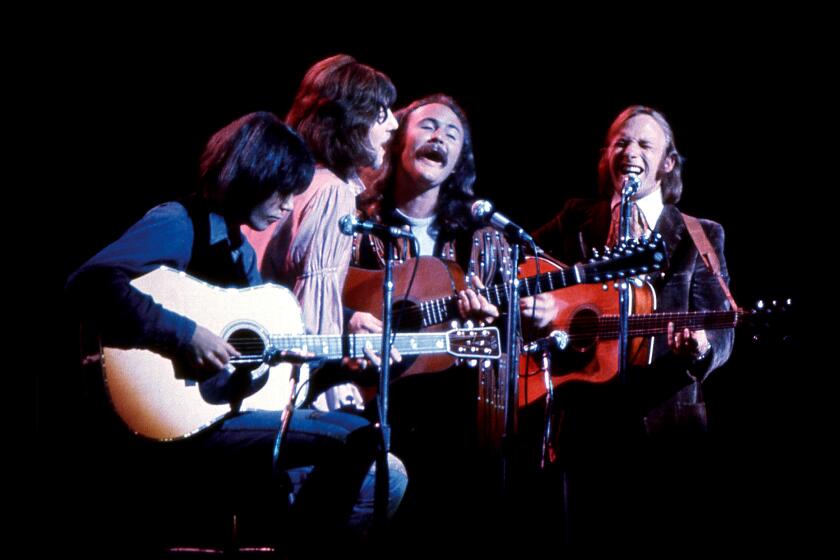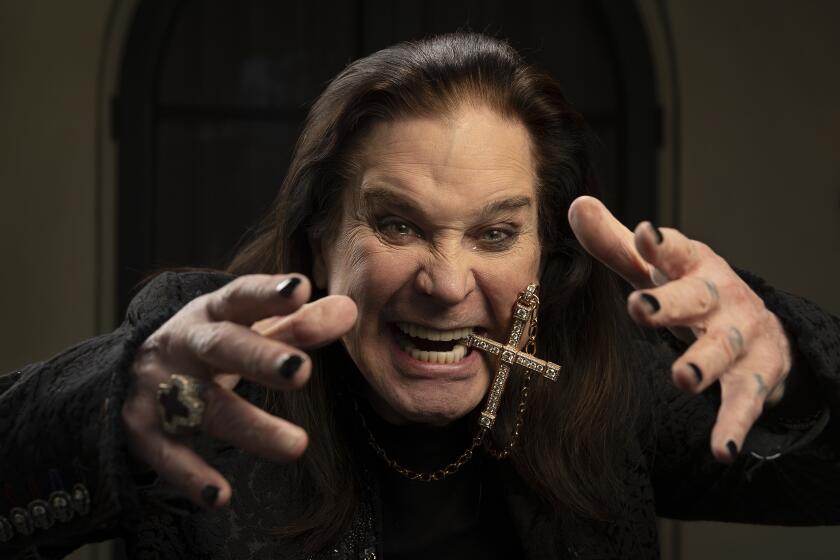Monk With a Mission
- Share via
One late afternoon last May, an unusual crowd packed into the swank top floor restaurant of the Music Center in Los Angeles. In the house were local politicos, nattily attired guests, members of the media, and, most important, just about every world-class jazz musician who calls L.A. home.
Herbie Hancock, Wayne Shorter, Billie Higgins, Charlie Haden and Peter Erskine--as well as Billy Dee Williams--showed up for the announcement of a deal between the acclaimed Thelonious Monk Institute and the Music Center, a pact that will, one hopes, usher jazz into the ranks of high culture in Los Angeles as never before.
Hancock will be the official artistic director of the operation, which will include concerts, lectures and educational programs, but the force of energy at the heart of it all is another Monk: Thelonious Monk Jr., a.k.a. T.S. Monk, son of the late legendary pianist-composer (for whom Monk the elder wrote “Little Rootie Tootie”).
Monk has a way with words and no lack of confidence, as he showed when he took the podium that afternoon. “The mission is to weave jazz into the cultural tapestry of America,” he said. “We have not done it yet, but we are certainly in the doorway. I’ve got a big combat boot that’s ready to kick the door in. We’re going to get busy.”
Junior got busy with his career when he moved in a jazz funk direction in the early ‘80s. He then dropped out of the music scene, but returned in the ‘90s with a sweet kind of vengeance and a remarkable ability to wear multiple hats.
As chairman of the institute, he has been an articulate spokesman who has helped it become a unique entity in the world. And, with the release this year of the all-star big band project “Monk on Monk” on the N2K label, he has finally squarely addressed the music of his famous father with inspiration and focus. A 10-piece band played the music in European festivals over the summer, but now a nationwide tour begins and will stop Tuesday in Santa Barbara’s picturesque Lobero Theater. The concert is being presented by Jazz Hall’s Ridah Omri, who is dedicating the concert to his late mother, who was killed in an accident last spring. Joining Monk will be his regular quintet and, as guests, vocalist Nnenna Freelon, tuba player Howard Johnson and saxophonist Bobby Watson.
Before leaving his East Coast home last week, Monk Jr. agreed to a phone interview, during which he spoke, as he plays, with friendly ferocity. Beneath his brashness, there was the drive of a man with a mission.
*
On your last few albums, you’ve had selective tunes of your father’s. What happened? What was the real impetus to embark on the Monk on Monk project?
I feel that the golden era of jazz composition has been from the mid-50s up until about 1970. In my quest to expose that music, I’ve had a sub-goal in there, which was, every once in a while, to lay down one of Thelonious’ compositions in a fashion that makes it crystal clear as to what this composition is all about. As for “Monk on Monk,” first of all, it was time. I had been out there for four years as a jazz artist. I established my validity as a bandleader and as a drummer. There’s no doubt that “he can do it, and he can do it without playing Monk and acting like Thelonious Monk all day and night.”
*
On the album, you have some stellar guest stars, including Herbie Hancock, Wayne Shorter and Wallace Roney. Were they all excited to be involved in the project?
Absolutely. When we approached people, I knew we had to approach them with something attractive, something they’ll want to do. So, playing a solo on “Crepescule with Nellie,” which even Thelonious didn’t do, was attractive to Wayne Shorter. Playing a Thelonious Monk composition that no one had ever heard before (“Two Timer”) was attractive to Herbie Hancock. More than any other jazz musician, Thelonious symbolizes uniqueness. He symbolizes originality. He is the quintessential prototype of what a jazz musician should be. Absolute belief in oneself. Absolute focus. Thelonious inspired those feelings in all of us. As soon as we started making this record, I turned to Don (Sickler, the trumpeter in Monk’s band) and said ‘Phew, this is everybody’s record. This ain’t no T.S. Monk record.’
*
On the “Monk on Monk” project, you picked some obscurities from his songbook, not the obvious ones. How did you come up with the tunes that you did?
I decided to pick family as the theme. It was a theme that Thelonious liked. When he liked you, he wrote a tune for you. In fact, I know that he liked himself because he wrote four songs named after himself. That accomplished two things: that gave me a theme for the album, and it also took me in some places with tunes that weren’t quite as familiar, like “Boo Boo’s Birthday” and “Jackie-ing” and the vocal version of “In Walked Bud.” Those tunes are not in the everyday Monk vocabulary. I felt it was important to play some things that weren’t necessarily commonplace. So there was a tune for me, a tune for Nellie, a tune for my sister Boo Boo, a tune for my cousin Jackie, a tune for his best friend, Bud Powell, a tune for his girlfriend Ruby.
*
You began your career in funk, and then returned as a straight-ahead jazz player. After that first chapter, did you always assume that you would eventually return to more of a mainstream jazz approach in your music?
No. Really, what happened was that my sister and my girlfriend died. They were integral parts of the T.S. Monk band. Suffice to say, that devastated me. So I stopped doing anything. I stopped playing the drums completely in 1984, and didn’t touch the drums again until 1991.
The only reason I got back into it was because, as chairman of the Monk Institute, someone thought it might be a nice thing to have me play a tune or two as an additional promotional tool, given that I could talk.
So then I just went crazy and got back into the music. If there’s anything one could describe as a shadow or a pressure on me, it’s the pressure to be absolutely drop-dead excellent every time out, simply because I’m not a genius, so there’s not that tolerance level for me. Actually, with this “Monk on Monk” project, I think all that is going to be behind me, that kind of pressure. Now, I’ve dealt with Dad, and everybody says, “Oh, he dealt with his father and he did a damn good job doing it.” So this is the final piece of the puzzle of T.S. Monk’s validity as a jazz artist.
*
Societal Maneuvers: The Santa Barbara Jazz Society, going strong in the past year-and-half, is hosting a benefit for itself--a good cause, for sure--in the lyrical outdoor venue of Las Positas Park on Sunday afternoon. It’s a good lineup, featuring the fine and too unsung young vocalist Karrin Allyson, who just released “Daydreams,” her fifth album for Concord. Also making music are pianist Cecilia Coleman, sax player Bob Kindred and the Santa Barbara City College Lunch Break Big Band, who proved their mettle at the Santa Barbara Jazz Festival two weekends back.
BE THERE
“Monk on Monk,” on Oct. 14 at 8 p.m. at the Lobero Theater, 33 W. Canon Perdido St. in Santa Barbara. Tickets are $35.-$40; 963-0404.
Lunch break--Karrin Allyson, Cecilia Coleman, Bob Kindred and the Santa Barbara City College Lunch Break Big Band, on Sunday from 12:30-5 p.m., at Las Positas Park amphitheater in Santa Barbara. Tickets are $15 in advance, $18 at the door; 682-5426.
More to Read
The biggest entertainment stories
Get our big stories about Hollywood, film, television, music, arts, culture and more right in your inbox as soon as they publish.
You may occasionally receive promotional content from the Los Angeles Times.
